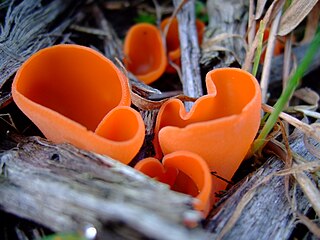Related Research Articles

Pezizomycotina make up most of the Ascomycota fungi and include most lichenized fungi too. Pezizomycotina contains the filamentous ascomycetes and is a subdivision of the Ascomycota. It is more or less synonymous with the older taxon Euascomycota. These fungi reproduce by fission rather than budding and this subdivision includes almost all the ascus fungi that have fruiting bodies visible to the naked eye.

Dothideomycetes is the largest and most diverse class of ascomycete fungi. It comprises 11 orders 90 families, 1,300 genera and over 19,000 known species. Traditionally, most of its members were included in the loculoascomycetes, which is not part of the currently accepted classification. This indicates that several traditional morphological features in the class are not unique and DNA sequence comparisons are important to define the class.
Capillataspora is a genus of fungi in the class Dothideomycetes. The relationship of this taxon to other taxa within the class is unknown. A monotypic genus, it contains the single species Capillataspora corticola.
Pseudonitschkia is a genus of fungi in the class Dothideomycetes. The relationship of this taxon to other taxa within the class is unknown. A monotypic genus, it contains the single species Pseudonitschkia parmotrematis. This was first found growing on rock in Venezuela and the holotype specimen is in the collection of the Natural History Museum, London.
Vizellopsis is a genus of fungi in the class Dothideomycetes and in the Asterinaceae family. A monotypic genus, it contains the single species Vizellopsis grevilleae.
Lophiosphaerella is a genus of fungi in the class Dothideomycetes. The relationship of this taxon to other taxa within the class is unknown. Also, the placement of this genus within the Dothideomycetes is uncertain. A monotypic genus, it contains the single species Lophiosphaerella euryae.
Leveillina is a genus of fungi in the class Dothideomycetes. The relationship of this taxon to other taxa within the class is unknown. Also, the placement of this genus within the Dothideomycetes is uncertain.
Cyrtidium is a genus of fungi in the class Dothideomycetes. The relationship of this taxon to other taxa within the class is unknown. Also, the placement of this genus within the Dothideomycetes is uncertain. A monotypic genus, it contains the single species Cyrtidium naevium.
Gloeodiscus is a genus of fungi in the class Dothideomycetes. The relationship of this taxon to other taxa within the class is unknown. Also, the placement of this genus within the Dothideomycetes is uncertain. A monotypic genus, it contains the single species Gloeodiscus nigrorufus.
Coccochorina is a genus of fungi in the class Dothideomycetes. The relationship of this taxon to other taxa within the class is unknown. Also, the placement of this genus within the Dothideomycetes is uncertain.
Ascostratum is a genus of fungi in the class Dothideomycetes. The relationship of this taxon to other taxa within the class is unknown. Also, the placement of this genus within the Dothideomycetes is uncertain.
Thyridaria is a genus of fungi in the class Dothideomycetes. The relationship of this taxon to other taxa within the class is unknown. Also, the placement of this genus within the Dothideomycetes is uncertain. The genus was first described by Pier Andrea Saccardo in 1875.
Teratoschaeta is a genus of fungi in the class Dothideomycetes. The relationship of this taxon to other taxa within the class is unknown. Also, the placement of this genus within the Dothideomycetes is uncertain. A monotypic genus, it contains the single species Teratoschaeta rondoniensis.
Syrropeltis is a genus of fungi in the class Dothideomycetes. The relationship of this taxon to other taxa within the class is unknown. Also, the placement of this genus within the Dothideomycetes is uncertain. A monotypic genus, it contains the single species Syrropeltis xylopiae.
Salsuginea is a genus of fungi in the class Dothideomycetes. The relationship of this taxon to other taxa within the class was unknown in 2007. Until Kevin D. Hyde & Tibpromma, 2013 introduced family Salsugineaceae within the order of Pleosporales.
Propolina is a genus of fungi in the class Dothideomycetes. The relationship of this taxon to other taxa within the class is unknown. Also, the placement of this genus within the Dothideomycetes is uncertain. A monotypic genus, it contains the single species Propolina cervina.
Pleosphaerellula is a genus of fungi in the class Dothideomycetes. The relationship of this taxon to other taxa within the class is unknown. Also, the placement of this genus within the Dothideomycetes is uncertain.
Placodothis is a genus of fungi in the class Dothideomycetes. The relationship of this taxon to other taxa within the class is unknown. Also, the placement of this genus within the Dothideomycetes is uncertain. A monotypic genus, it contains the single species Placodothis petrakii.
Physalosporopsis is a genus of fungi in the class Dothideomycetes. The relationship of this taxon to other taxa within the class is unknown. Also, the placement of this genus within the Dothideomycetes is uncertain. A monotypic genus, it contains the single species Physalosporopsis rhizophoricola.
Coniella is a fungus genus in the family Schizoparmeaceae, which contains 65 species recorded in the database Mycobank. This genus Coniella are reported as a typical plant pathogenic fungi for grape, eucalyptus and several plant. It mainly found in Europe, Asian, also South Africa. less report in American, only one paper published new spaces founded.
References
- ↑ Lumbsch TH, Huhndorf SM. (December 2007). "Outline of Ascomycota – 2007". Myconet. Chicago, USA: The Field Museum, Department of Botany. 13: 1–58.
- ↑ Alvarez, L. V.; Groenewald, J. Z.; Crous, P. W. (2016-09-01). "Revising the Schizoparmaceae: Coniella and its synonyms Pilidiella and Schizoparme". Studies in Mycology. 85: 1–34. doi:10.1016/j.simyco.2016.09.001. ISSN 0166-0616. PMC 5066162 . PMID 27766001.